Entrepreneurship & Small Business Management: Ventures, Economy, UK
VerifiedAdded on 2022/12/14
|15
|4509
|199
Report
AI Summary
This report provides a comprehensive overview of entrepreneurship and small business management, covering various entrepreneurial ventures and their typologies. It discusses the similarities and differences between these ventures and assesses the impact of micro and small businesses on the UK economy using relevant data and statistics. The importance of small businesses and start-ups in the growth of the social economy is also highlighted. Furthermore, the report examines the characteristics, traits, and skills of successful entrepreneurs, differentiating them from business managers. It assesses how aspects of the entrepreneurial personality reflect motivation and mindset, using the OCEAN model. Finally, the report explores how background and experience can either hinder or foster entrepreneurship, providing a detailed analysis of the factors contributing to success in the entrepreneurial landscape. Desklib offers similar solved assignments and past papers.
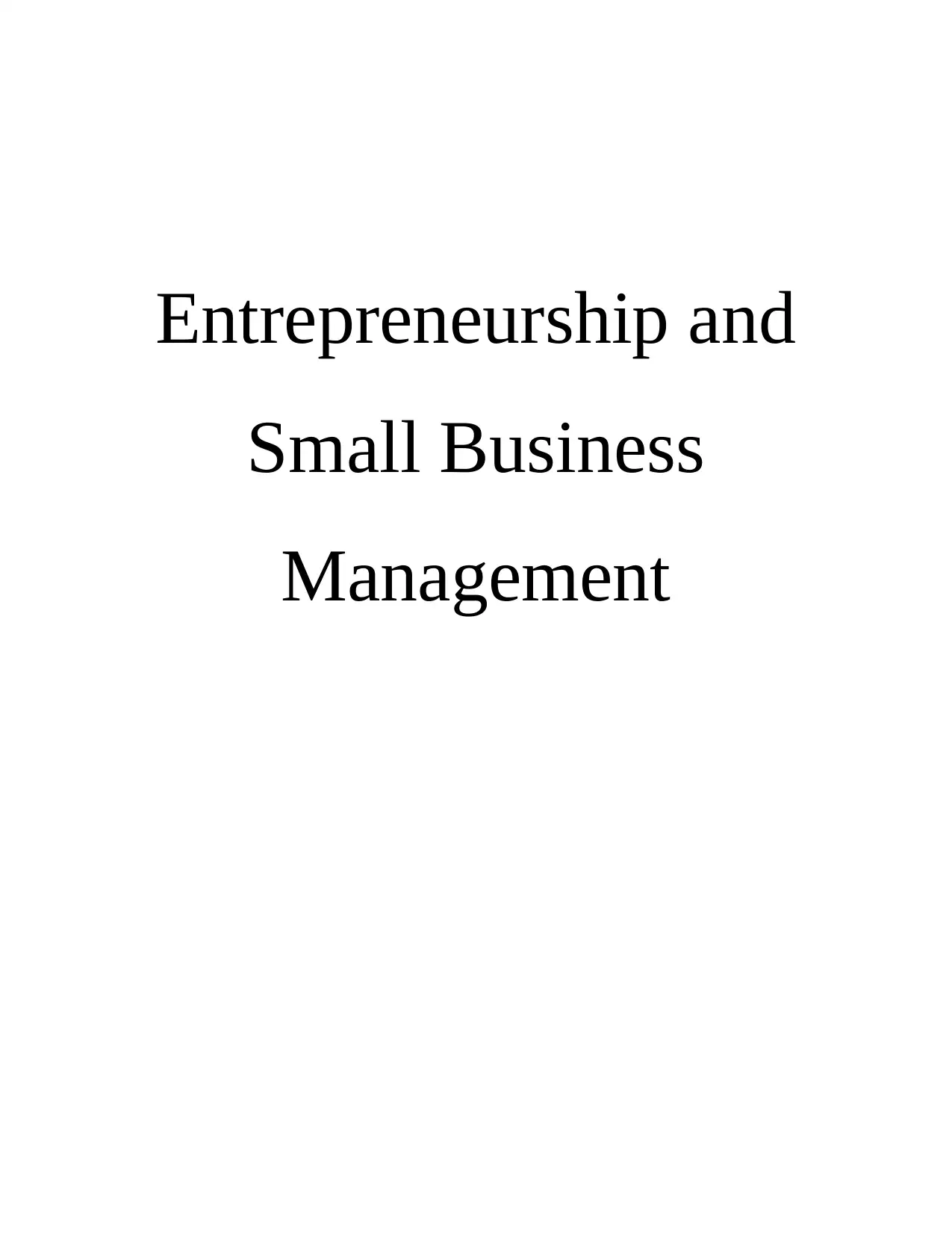
Entrepreneurship and
Small Business
Management
Small Business
Management
Paraphrase This Document
Need a fresh take? Get an instant paraphrase of this document with our AI Paraphraser
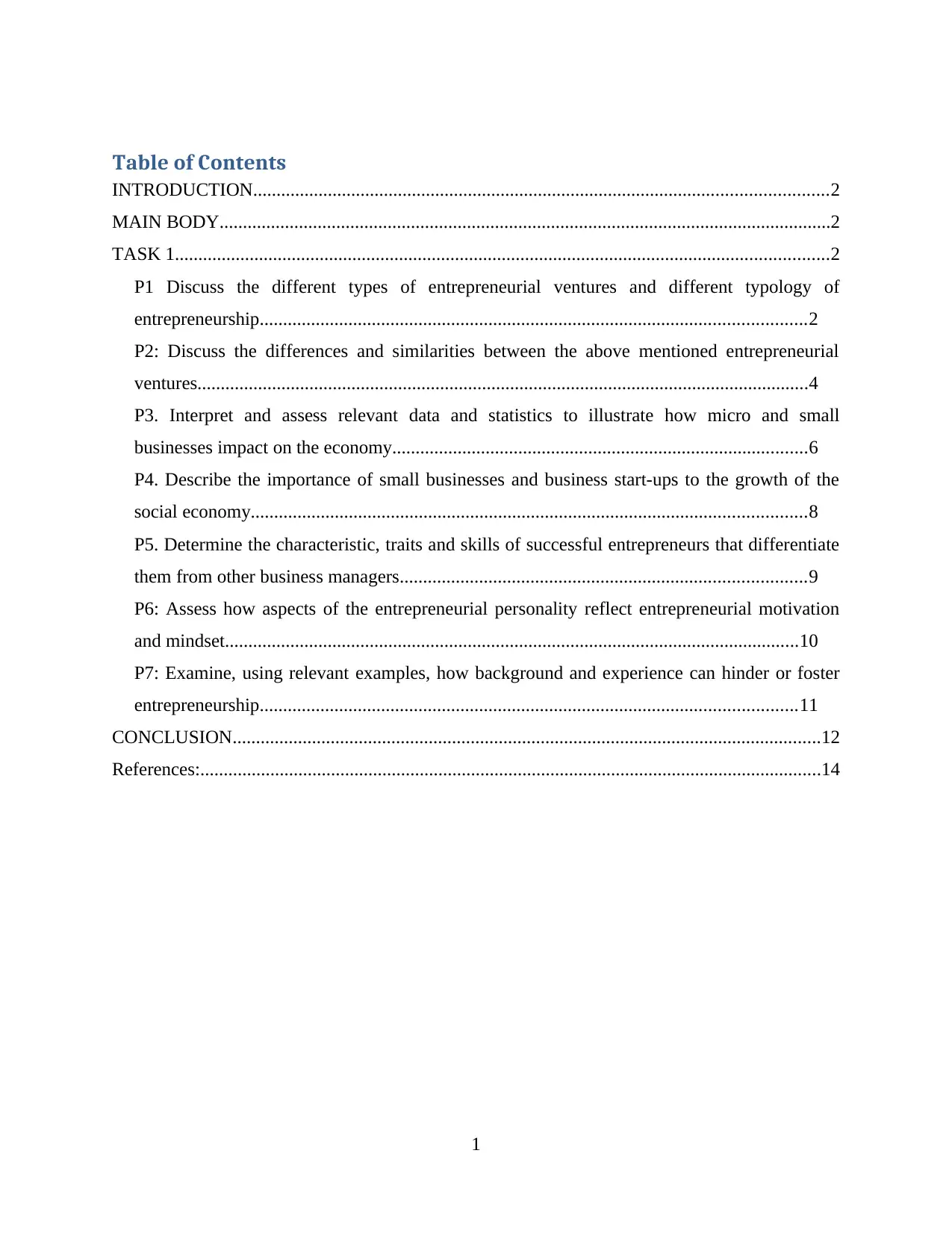
Table of Contents
INTRODUCTION...........................................................................................................................2
MAIN BODY...................................................................................................................................2
TASK 1............................................................................................................................................2
P1 Discuss the different types of entrepreneurial ventures and different typology of
entrepreneurship.....................................................................................................................2
P2: Discuss the differences and similarities between the above mentioned entrepreneurial
ventures...................................................................................................................................4
P3. Interpret and assess relevant data and statistics to illustrate how micro and small
businesses impact on the economy.........................................................................................6
P4. Describe the importance of small businesses and business start-ups to the growth of the
social economy.......................................................................................................................8
P5. Determine the characteristic, traits and skills of successful entrepreneurs that differentiate
them from other business managers.......................................................................................9
P6: Assess how aspects of the entrepreneurial personality reflect entrepreneurial motivation
and mindset...........................................................................................................................10
P7: Examine, using relevant examples, how background and experience can hinder or foster
entrepreneurship...................................................................................................................11
CONCLUSION..............................................................................................................................12
References:.....................................................................................................................................14
1
INTRODUCTION...........................................................................................................................2
MAIN BODY...................................................................................................................................2
TASK 1............................................................................................................................................2
P1 Discuss the different types of entrepreneurial ventures and different typology of
entrepreneurship.....................................................................................................................2
P2: Discuss the differences and similarities between the above mentioned entrepreneurial
ventures...................................................................................................................................4
P3. Interpret and assess relevant data and statistics to illustrate how micro and small
businesses impact on the economy.........................................................................................6
P4. Describe the importance of small businesses and business start-ups to the growth of the
social economy.......................................................................................................................8
P5. Determine the characteristic, traits and skills of successful entrepreneurs that differentiate
them from other business managers.......................................................................................9
P6: Assess how aspects of the entrepreneurial personality reflect entrepreneurial motivation
and mindset...........................................................................................................................10
P7: Examine, using relevant examples, how background and experience can hinder or foster
entrepreneurship...................................................................................................................11
CONCLUSION..............................................................................................................................12
References:.....................................................................................................................................14
1
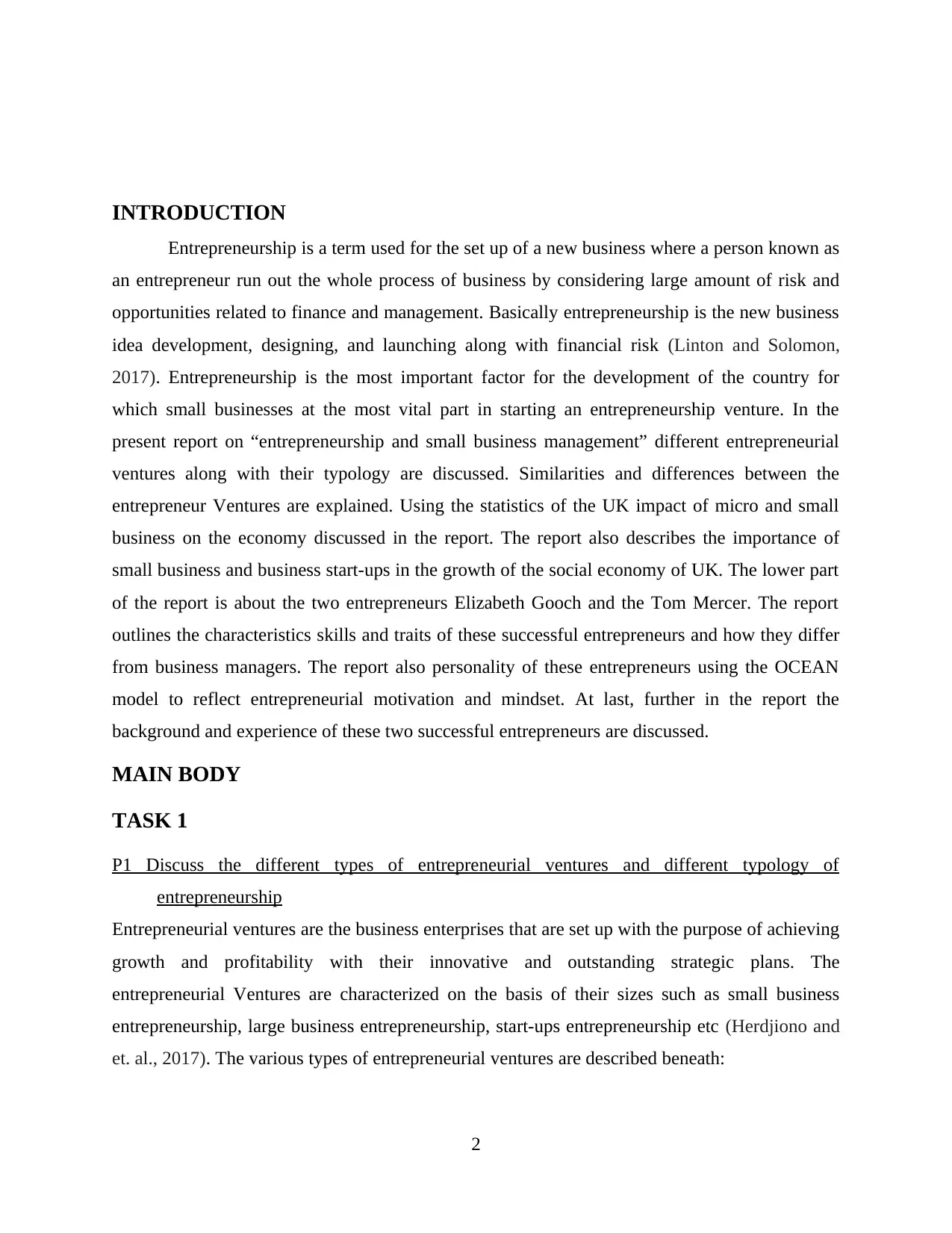
INTRODUCTION
Entrepreneurship is a term used for the set up of a new business where a person known as
an entrepreneur run out the whole process of business by considering large amount of risk and
opportunities related to finance and management. Basically entrepreneurship is the new business
idea development, designing, and launching along with financial risk (Linton and Solomon,
2017). Entrepreneurship is the most important factor for the development of the country for
which small businesses at the most vital part in starting an entrepreneurship venture. In the
present report on “entrepreneurship and small business management” different entrepreneurial
ventures along with their typology are discussed. Similarities and differences between the
entrepreneur Ventures are explained. Using the statistics of the UK impact of micro and small
business on the economy discussed in the report. The report also describes the importance of
small business and business start-ups in the growth of the social economy of UK. The lower part
of the report is about the two entrepreneurs Elizabeth Gooch and the Tom Mercer. The report
outlines the characteristics skills and traits of these successful entrepreneurs and how they differ
from business managers. The report also personality of these entrepreneurs using the OCEAN
model to reflect entrepreneurial motivation and mindset. At last, further in the report the
background and experience of these two successful entrepreneurs are discussed.
MAIN BODY
TASK 1
P1 Discuss the different types of entrepreneurial ventures and different typology of
entrepreneurship
Entrepreneurial ventures are the business enterprises that are set up with the purpose of achieving
growth and profitability with their innovative and outstanding strategic plans. The
entrepreneurial Ventures are characterized on the basis of their sizes such as small business
entrepreneurship, large business entrepreneurship, start-ups entrepreneurship etc (Herdjiono and
et. al., 2017). The various types of entrepreneurial ventures are described beneath:
2
Entrepreneurship is a term used for the set up of a new business where a person known as
an entrepreneur run out the whole process of business by considering large amount of risk and
opportunities related to finance and management. Basically entrepreneurship is the new business
idea development, designing, and launching along with financial risk (Linton and Solomon,
2017). Entrepreneurship is the most important factor for the development of the country for
which small businesses at the most vital part in starting an entrepreneurship venture. In the
present report on “entrepreneurship and small business management” different entrepreneurial
ventures along with their typology are discussed. Similarities and differences between the
entrepreneur Ventures are explained. Using the statistics of the UK impact of micro and small
business on the economy discussed in the report. The report also describes the importance of
small business and business start-ups in the growth of the social economy of UK. The lower part
of the report is about the two entrepreneurs Elizabeth Gooch and the Tom Mercer. The report
outlines the characteristics skills and traits of these successful entrepreneurs and how they differ
from business managers. The report also personality of these entrepreneurs using the OCEAN
model to reflect entrepreneurial motivation and mindset. At last, further in the report the
background and experience of these two successful entrepreneurs are discussed.
MAIN BODY
TASK 1
P1 Discuss the different types of entrepreneurial ventures and different typology of
entrepreneurship
Entrepreneurial ventures are the business enterprises that are set up with the purpose of achieving
growth and profitability with their innovative and outstanding strategic plans. The
entrepreneurial Ventures are characterized on the basis of their sizes such as small business
entrepreneurship, large business entrepreneurship, start-ups entrepreneurship etc (Herdjiono and
et. al., 2017). The various types of entrepreneurial ventures are described beneath:
2
⊘ This is a preview!⊘
Do you want full access?
Subscribe today to unlock all pages.

Trusted by 1+ million students worldwide
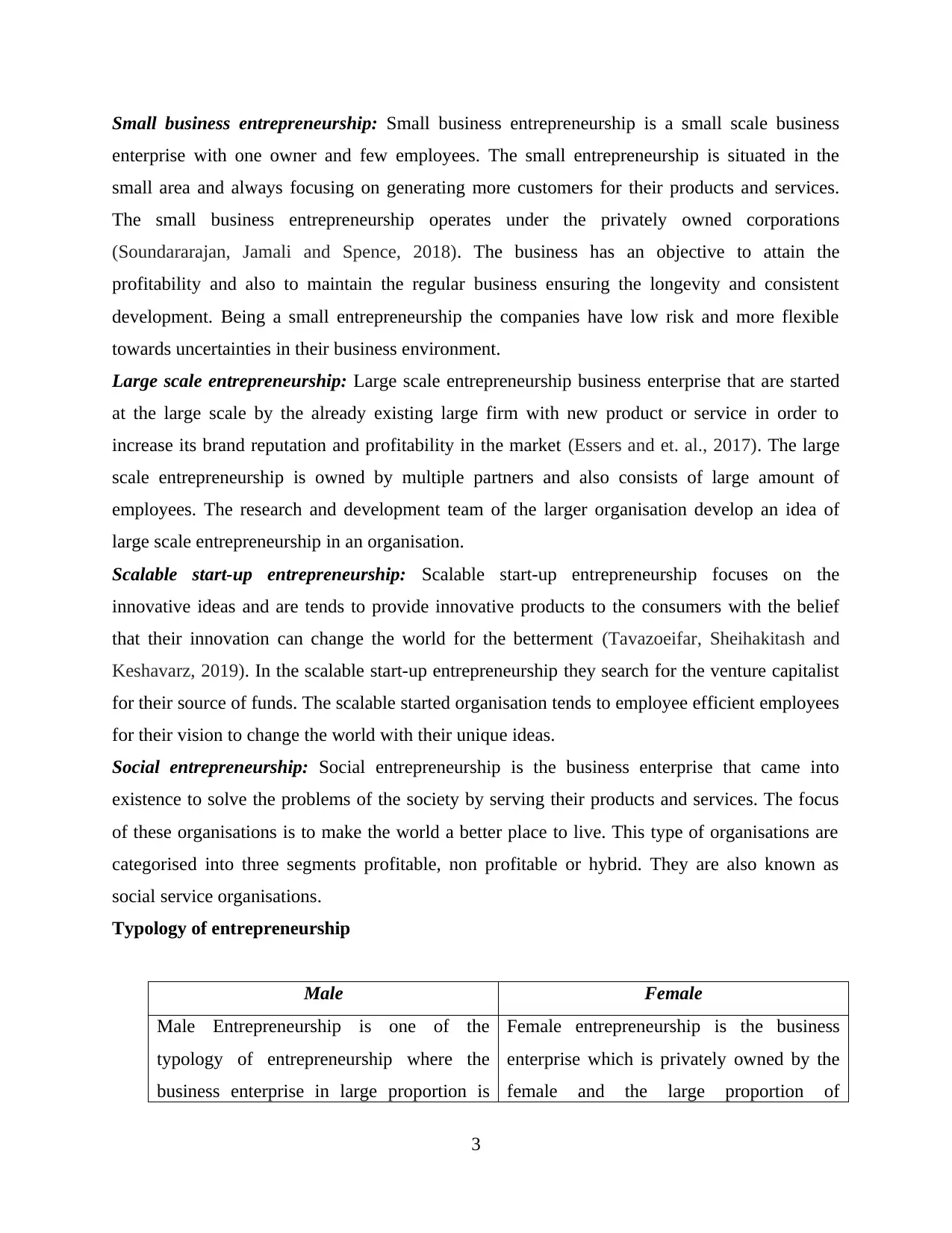
Small business entrepreneurship: Small business entrepreneurship is a small scale business
enterprise with one owner and few employees. The small entrepreneurship is situated in the
small area and always focusing on generating more customers for their products and services.
The small business entrepreneurship operates under the privately owned corporations
(Soundararajan, Jamali and Spence, 2018). The business has an objective to attain the
profitability and also to maintain the regular business ensuring the longevity and consistent
development. Being a small entrepreneurship the companies have low risk and more flexible
towards uncertainties in their business environment.
Large scale entrepreneurship: Large scale entrepreneurship business enterprise that are started
at the large scale by the already existing large firm with new product or service in order to
increase its brand reputation and profitability in the market (Essers and et. al., 2017). The large
scale entrepreneurship is owned by multiple partners and also consists of large amount of
employees. The research and development team of the larger organisation develop an idea of
large scale entrepreneurship in an organisation.
Scalable start-up entrepreneurship: Scalable start-up entrepreneurship focuses on the
innovative ideas and are tends to provide innovative products to the consumers with the belief
that their innovation can change the world for the betterment (Tavazoeifar, Sheihakitash and
Keshavarz, 2019). In the scalable start-up entrepreneurship they search for the venture capitalist
for their source of funds. The scalable started organisation tends to employee efficient employees
for their vision to change the world with their unique ideas.
Social entrepreneurship: Social entrepreneurship is the business enterprise that came into
existence to solve the problems of the society by serving their products and services. The focus
of these organisations is to make the world a better place to live. This type of organisations are
categorised into three segments profitable, non profitable or hybrid. They are also known as
social service organisations.
Typology of entrepreneurship
Male Female
Male Entrepreneurship is one of the
typology of entrepreneurship where the
business enterprise in large proportion is
Female entrepreneurship is the business
enterprise which is privately owned by the
female and the large proportion of
3
enterprise with one owner and few employees. The small entrepreneurship is situated in the
small area and always focusing on generating more customers for their products and services.
The small business entrepreneurship operates under the privately owned corporations
(Soundararajan, Jamali and Spence, 2018). The business has an objective to attain the
profitability and also to maintain the regular business ensuring the longevity and consistent
development. Being a small entrepreneurship the companies have low risk and more flexible
towards uncertainties in their business environment.
Large scale entrepreneurship: Large scale entrepreneurship business enterprise that are started
at the large scale by the already existing large firm with new product or service in order to
increase its brand reputation and profitability in the market (Essers and et. al., 2017). The large
scale entrepreneurship is owned by multiple partners and also consists of large amount of
employees. The research and development team of the larger organisation develop an idea of
large scale entrepreneurship in an organisation.
Scalable start-up entrepreneurship: Scalable start-up entrepreneurship focuses on the
innovative ideas and are tends to provide innovative products to the consumers with the belief
that their innovation can change the world for the betterment (Tavazoeifar, Sheihakitash and
Keshavarz, 2019). In the scalable start-up entrepreneurship they search for the venture capitalist
for their source of funds. The scalable started organisation tends to employee efficient employees
for their vision to change the world with their unique ideas.
Social entrepreneurship: Social entrepreneurship is the business enterprise that came into
existence to solve the problems of the society by serving their products and services. The focus
of these organisations is to make the world a better place to live. This type of organisations are
categorised into three segments profitable, non profitable or hybrid. They are also known as
social service organisations.
Typology of entrepreneurship
Male Female
Male Entrepreneurship is one of the
typology of entrepreneurship where the
business enterprise in large proportion is
Female entrepreneurship is the business
enterprise which is privately owned by the
female and the large proportion of
3
Paraphrase This Document
Need a fresh take? Get an instant paraphrase of this document with our AI Paraphraser
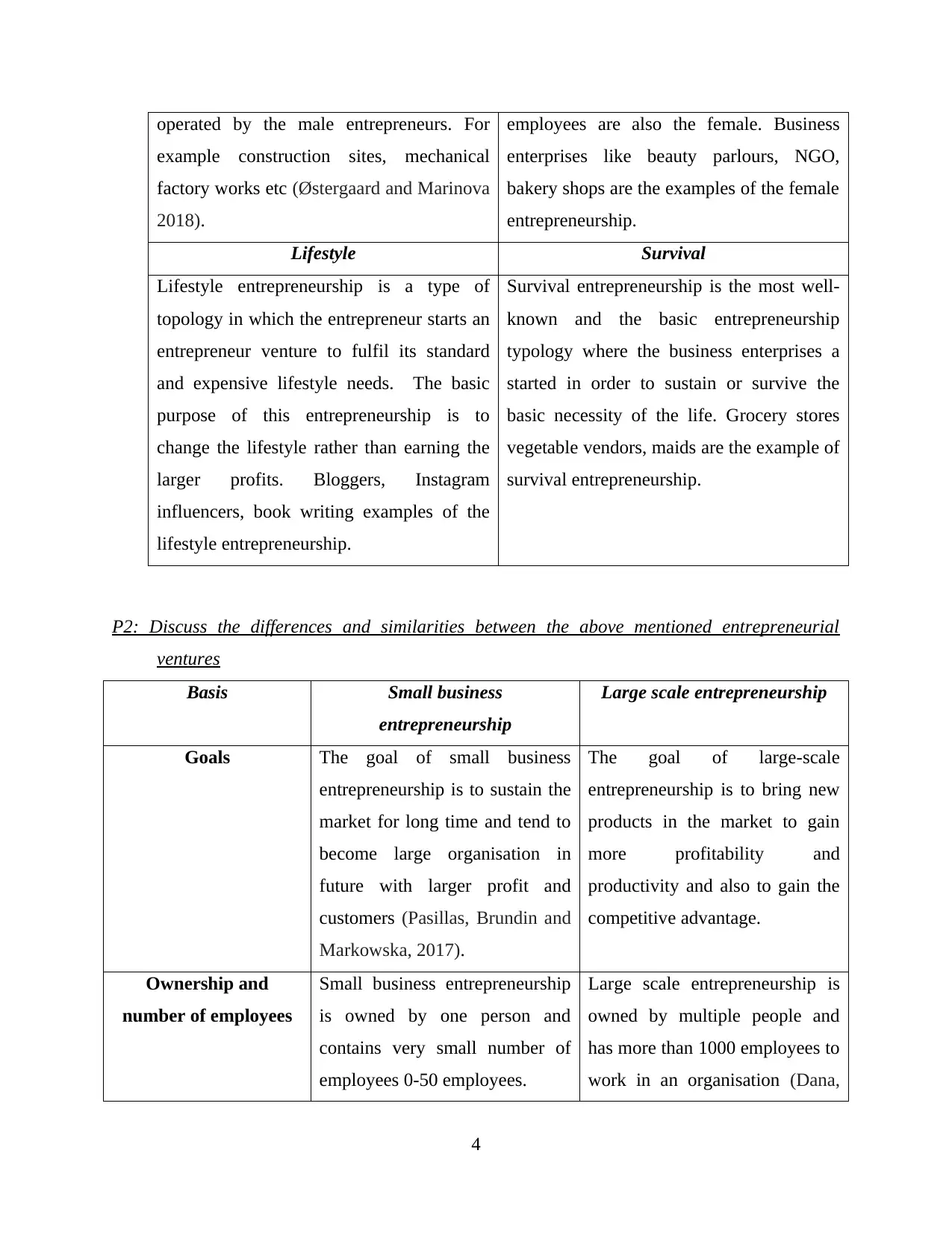
operated by the male entrepreneurs. For
example construction sites, mechanical
factory works etc (Østergaard and Marinova
2018).
employees are also the female. Business
enterprises like beauty parlours, NGO,
bakery shops are the examples of the female
entrepreneurship.
Lifestyle Survival
Lifestyle entrepreneurship is a type of
topology in which the entrepreneur starts an
entrepreneur venture to fulfil its standard
and expensive lifestyle needs. The basic
purpose of this entrepreneurship is to
change the lifestyle rather than earning the
larger profits. Bloggers, Instagram
influencers, book writing examples of the
lifestyle entrepreneurship.
Survival entrepreneurship is the most well-
known and the basic entrepreneurship
typology where the business enterprises a
started in order to sustain or survive the
basic necessity of the life. Grocery stores
vegetable vendors, maids are the example of
survival entrepreneurship.
P2: Discuss the differences and similarities between the above mentioned entrepreneurial
ventures
Basis Small business
entrepreneurship
Large scale entrepreneurship
Goals The goal of small business
entrepreneurship is to sustain the
market for long time and tend to
become large organisation in
future with larger profit and
customers (Pasillas, Brundin and
Markowska, 2017).
The goal of large-scale
entrepreneurship is to bring new
products in the market to gain
more profitability and
productivity and also to gain the
competitive advantage.
Ownership and
number of employees
Small business entrepreneurship
is owned by one person and
contains very small number of
employees 0-50 employees.
Large scale entrepreneurship is
owned by multiple people and
has more than 1000 employees to
work in an organisation (Dana,
4
example construction sites, mechanical
factory works etc (Østergaard and Marinova
2018).
employees are also the female. Business
enterprises like beauty parlours, NGO,
bakery shops are the examples of the female
entrepreneurship.
Lifestyle Survival
Lifestyle entrepreneurship is a type of
topology in which the entrepreneur starts an
entrepreneur venture to fulfil its standard
and expensive lifestyle needs. The basic
purpose of this entrepreneurship is to
change the lifestyle rather than earning the
larger profits. Bloggers, Instagram
influencers, book writing examples of the
lifestyle entrepreneurship.
Survival entrepreneurship is the most well-
known and the basic entrepreneurship
typology where the business enterprises a
started in order to sustain or survive the
basic necessity of the life. Grocery stores
vegetable vendors, maids are the example of
survival entrepreneurship.
P2: Discuss the differences and similarities between the above mentioned entrepreneurial
ventures
Basis Small business
entrepreneurship
Large scale entrepreneurship
Goals The goal of small business
entrepreneurship is to sustain the
market for long time and tend to
become large organisation in
future with larger profit and
customers (Pasillas, Brundin and
Markowska, 2017).
The goal of large-scale
entrepreneurship is to bring new
products in the market to gain
more profitability and
productivity and also to gain the
competitive advantage.
Ownership and
number of employees
Small business entrepreneurship
is owned by one person and
contains very small number of
employees 0-50 employees.
Large scale entrepreneurship is
owned by multiple people and
has more than 1000 employees to
work in an organisation (Dana,
4
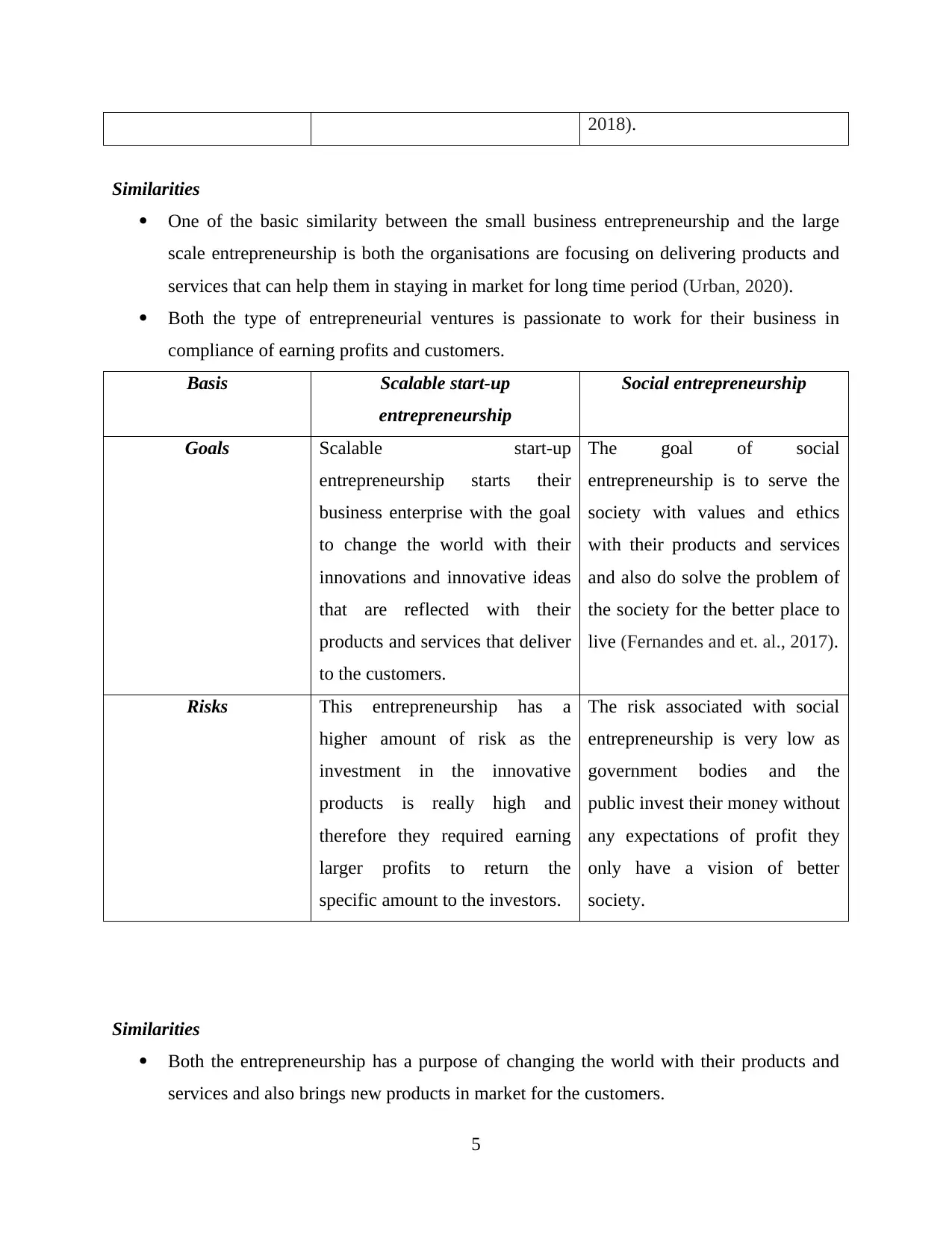
2018).
Similarities
One of the basic similarity between the small business entrepreneurship and the large
scale entrepreneurship is both the organisations are focusing on delivering products and
services that can help them in staying in market for long time period (Urban, 2020).
Both the type of entrepreneurial ventures is passionate to work for their business in
compliance of earning profits and customers.
Basis Scalable start-up
entrepreneurship
Social entrepreneurship
Goals Scalable start-up
entrepreneurship starts their
business enterprise with the goal
to change the world with their
innovations and innovative ideas
that are reflected with their
products and services that deliver
to the customers.
The goal of social
entrepreneurship is to serve the
society with values and ethics
with their products and services
and also do solve the problem of
the society for the better place to
live (Fernandes and et. al., 2017).
Risks This entrepreneurship has a
higher amount of risk as the
investment in the innovative
products is really high and
therefore they required earning
larger profits to return the
specific amount to the investors.
The risk associated with social
entrepreneurship is very low as
government bodies and the
public invest their money without
any expectations of profit they
only have a vision of better
society.
Similarities
Both the entrepreneurship has a purpose of changing the world with their products and
services and also brings new products in market for the customers.
5
Similarities
One of the basic similarity between the small business entrepreneurship and the large
scale entrepreneurship is both the organisations are focusing on delivering products and
services that can help them in staying in market for long time period (Urban, 2020).
Both the type of entrepreneurial ventures is passionate to work for their business in
compliance of earning profits and customers.
Basis Scalable start-up
entrepreneurship
Social entrepreneurship
Goals Scalable start-up
entrepreneurship starts their
business enterprise with the goal
to change the world with their
innovations and innovative ideas
that are reflected with their
products and services that deliver
to the customers.
The goal of social
entrepreneurship is to serve the
society with values and ethics
with their products and services
and also do solve the problem of
the society for the better place to
live (Fernandes and et. al., 2017).
Risks This entrepreneurship has a
higher amount of risk as the
investment in the innovative
products is really high and
therefore they required earning
larger profits to return the
specific amount to the investors.
The risk associated with social
entrepreneurship is very low as
government bodies and the
public invest their money without
any expectations of profit they
only have a vision of better
society.
Similarities
Both the entrepreneurship has a purpose of changing the world with their products and
services and also brings new products in market for the customers.
5
⊘ This is a preview!⊘
Do you want full access?
Subscribe today to unlock all pages.

Trusted by 1+ million students worldwide
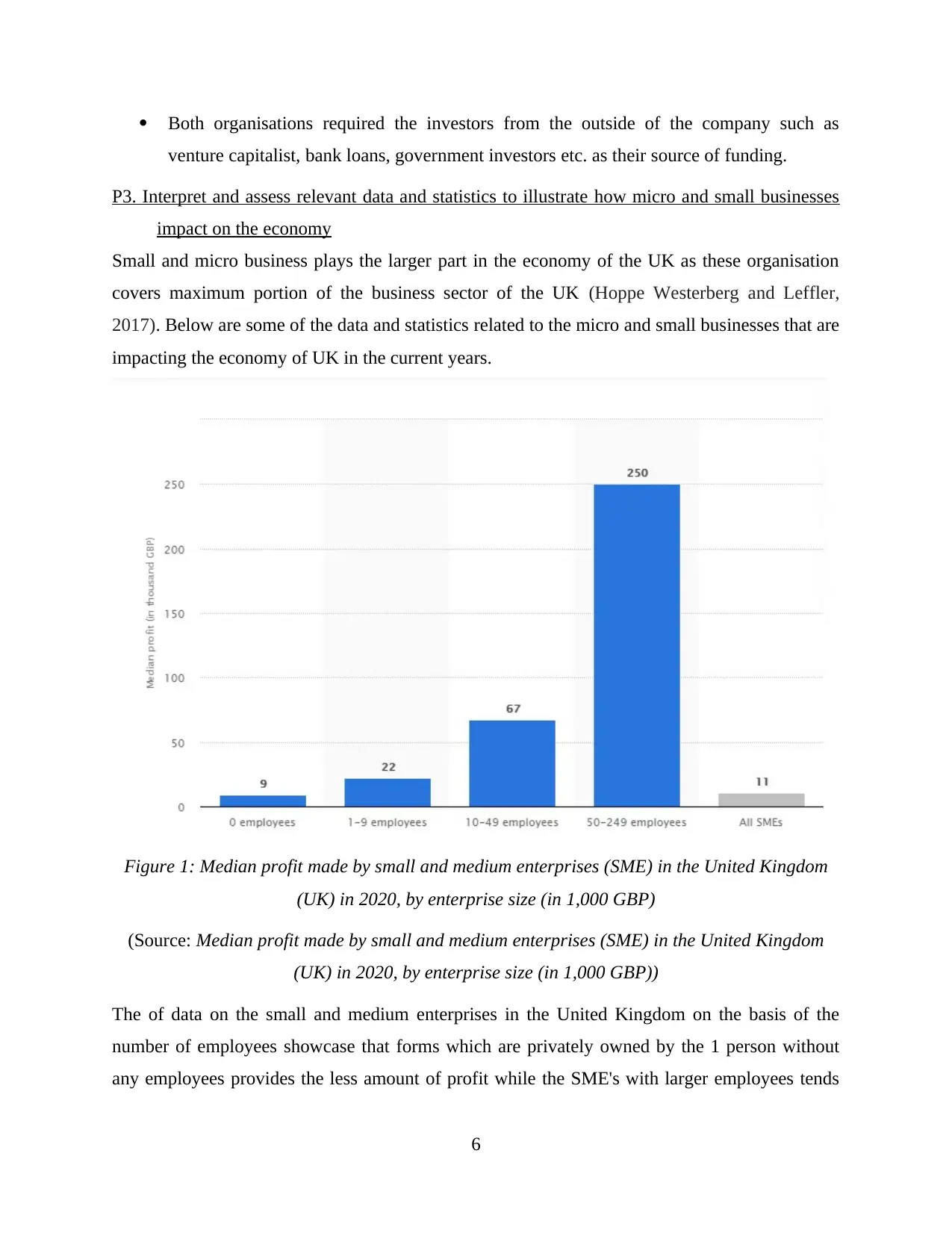
Both organisations required the investors from the outside of the company such as
venture capitalist, bank loans, government investors etc. as their source of funding.
P3. Interpret and assess relevant data and statistics to illustrate how micro and small businesses
impact on the economy
Small and micro business plays the larger part in the economy of the UK as these organisation
covers maximum portion of the business sector of the UK (Hoppe Westerberg and Leffler,
2017). Below are some of the data and statistics related to the micro and small businesses that are
impacting the economy of UK in the current years.
Figure 1: Median profit made by small and medium enterprises (SME) in the United Kingdom
(UK) in 2020, by enterprise size (in 1,000 GBP)
(Source: Median profit made by small and medium enterprises (SME) in the United Kingdom
(UK) in 2020, by enterprise size (in 1,000 GBP))
The of data on the small and medium enterprises in the United Kingdom on the basis of the
number of employees showcase that forms which are privately owned by the 1 person without
any employees provides the less amount of profit while the SME's with larger employees tends
6
venture capitalist, bank loans, government investors etc. as their source of funding.
P3. Interpret and assess relevant data and statistics to illustrate how micro and small businesses
impact on the economy
Small and micro business plays the larger part in the economy of the UK as these organisation
covers maximum portion of the business sector of the UK (Hoppe Westerberg and Leffler,
2017). Below are some of the data and statistics related to the micro and small businesses that are
impacting the economy of UK in the current years.
Figure 1: Median profit made by small and medium enterprises (SME) in the United Kingdom
(UK) in 2020, by enterprise size (in 1,000 GBP)
(Source: Median profit made by small and medium enterprises (SME) in the United Kingdom
(UK) in 2020, by enterprise size (in 1,000 GBP))
The of data on the small and medium enterprises in the United Kingdom on the basis of the
number of employees showcase that forms which are privately owned by the 1 person without
any employees provides the less amount of profit while the SME's with larger employees tends
6
Paraphrase This Document
Need a fresh take? Get an instant paraphrase of this document with our AI Paraphraser
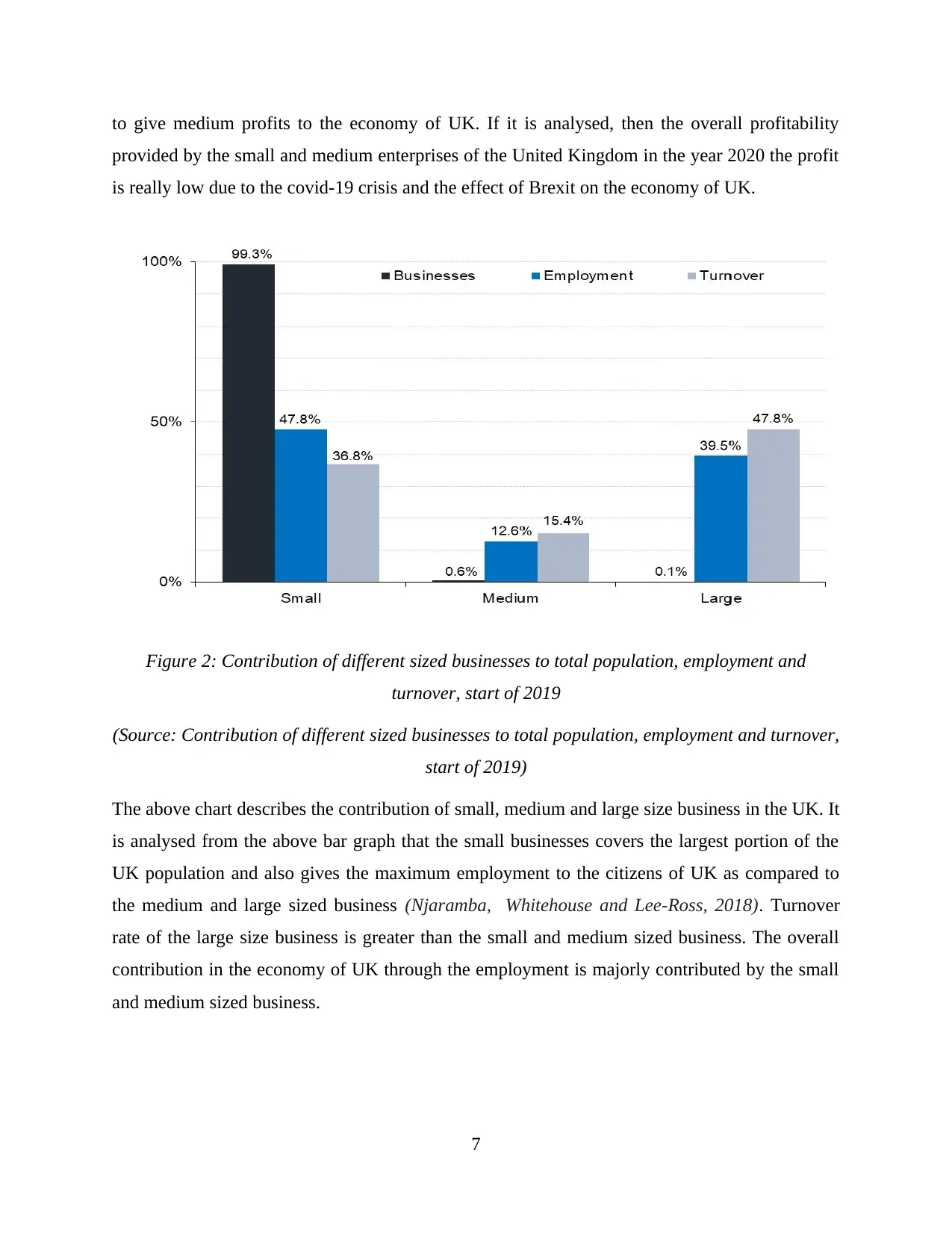
to give medium profits to the economy of UK. If it is analysed, then the overall profitability
provided by the small and medium enterprises of the United Kingdom in the year 2020 the profit
is really low due to the covid-19 crisis and the effect of Brexit on the economy of UK.
Figure 2: Contribution of different sized businesses to total population, employment and
turnover, start of 2019
(Source: Contribution of different sized businesses to total population, employment and turnover,
start of 2019)
The above chart describes the contribution of small, medium and large size business in the UK. It
is analysed from the above bar graph that the small businesses covers the largest portion of the
UK population and also gives the maximum employment to the citizens of UK as compared to
the medium and large sized business (Njaramba, Whitehouse and Lee-Ross, 2018). Turnover
rate of the large size business is greater than the small and medium sized business. The overall
contribution in the economy of UK through the employment is majorly contributed by the small
and medium sized business.
7
provided by the small and medium enterprises of the United Kingdom in the year 2020 the profit
is really low due to the covid-19 crisis and the effect of Brexit on the economy of UK.
Figure 2: Contribution of different sized businesses to total population, employment and
turnover, start of 2019
(Source: Contribution of different sized businesses to total population, employment and turnover,
start of 2019)
The above chart describes the contribution of small, medium and large size business in the UK. It
is analysed from the above bar graph that the small businesses covers the largest portion of the
UK population and also gives the maximum employment to the citizens of UK as compared to
the medium and large sized business (Njaramba, Whitehouse and Lee-Ross, 2018). Turnover
rate of the large size business is greater than the small and medium sized business. The overall
contribution in the economy of UK through the employment is majorly contributed by the small
and medium sized business.
7
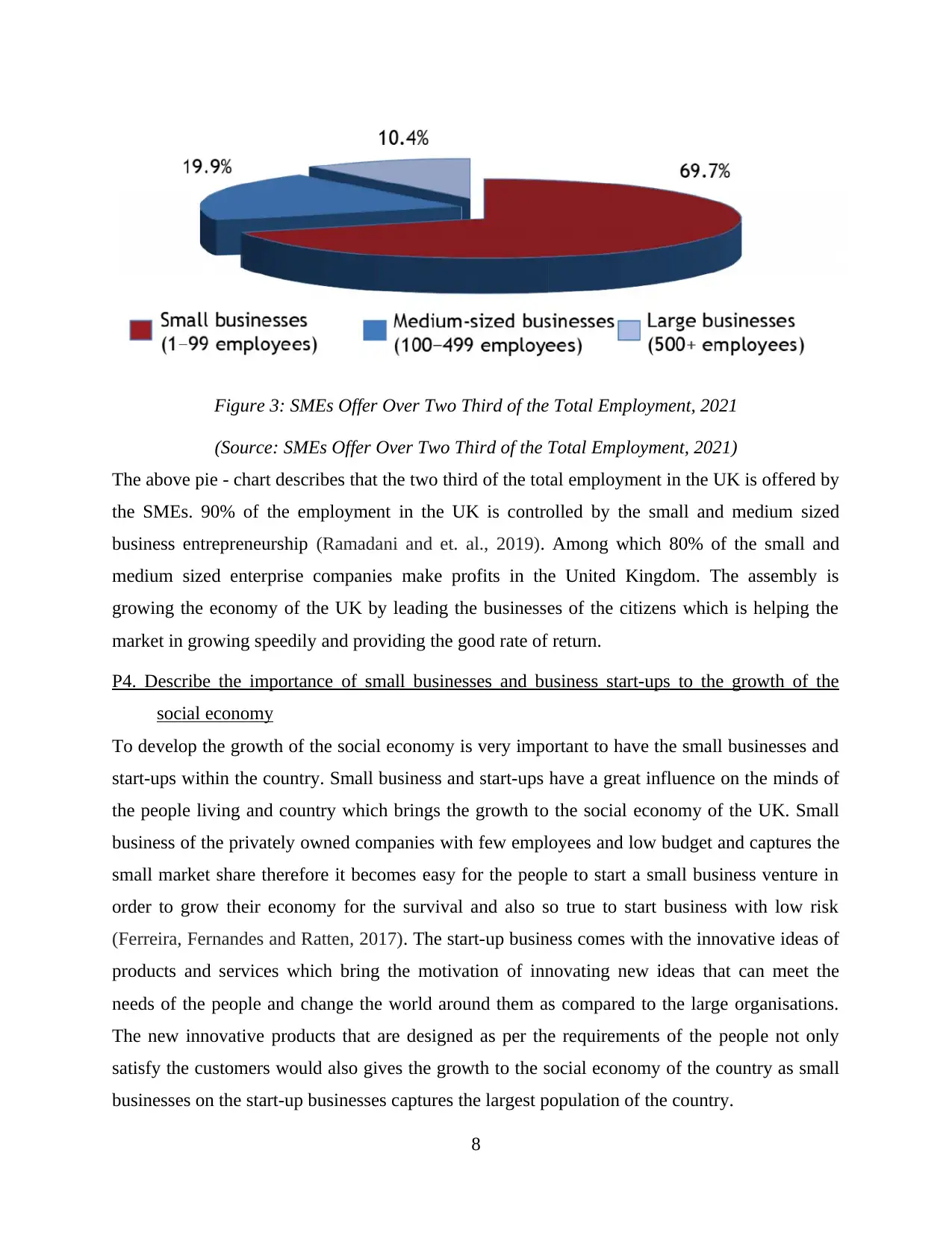
Figure 3: SMEs Offer Over Two Third of the Total Employment, 2021
(Source: SMEs Offer Over Two Third of the Total Employment, 2021)
The above pie - chart describes that the two third of the total employment in the UK is offered by
the SMEs. 90% of the employment in the UK is controlled by the small and medium sized
business entrepreneurship (Ramadani and et. al., 2019). Among which 80% of the small and
medium sized enterprise companies make profits in the United Kingdom. The assembly is
growing the economy of the UK by leading the businesses of the citizens which is helping the
market in growing speedily and providing the good rate of return.
P4. Describe the importance of small businesses and business start-ups to the growth of the
social economy
To develop the growth of the social economy is very important to have the small businesses and
start-ups within the country. Small business and start-ups have a great influence on the minds of
the people living and country which brings the growth to the social economy of the UK. Small
business of the privately owned companies with few employees and low budget and captures the
small market share therefore it becomes easy for the people to start a small business venture in
order to grow their economy for the survival and also so true to start business with low risk
(Ferreira, Fernandes and Ratten, 2017). The start-up business comes with the innovative ideas of
products and services which bring the motivation of innovating new ideas that can meet the
needs of the people and change the world around them as compared to the large organisations.
The new innovative products that are designed as per the requirements of the people not only
satisfy the customers would also gives the growth to the social economy of the country as small
businesses on the start-up businesses captures the largest population of the country.
8
(Source: SMEs Offer Over Two Third of the Total Employment, 2021)
The above pie - chart describes that the two third of the total employment in the UK is offered by
the SMEs. 90% of the employment in the UK is controlled by the small and medium sized
business entrepreneurship (Ramadani and et. al., 2019). Among which 80% of the small and
medium sized enterprise companies make profits in the United Kingdom. The assembly is
growing the economy of the UK by leading the businesses of the citizens which is helping the
market in growing speedily and providing the good rate of return.
P4. Describe the importance of small businesses and business start-ups to the growth of the
social economy
To develop the growth of the social economy is very important to have the small businesses and
start-ups within the country. Small business and start-ups have a great influence on the minds of
the people living and country which brings the growth to the social economy of the UK. Small
business of the privately owned companies with few employees and low budget and captures the
small market share therefore it becomes easy for the people to start a small business venture in
order to grow their economy for the survival and also so true to start business with low risk
(Ferreira, Fernandes and Ratten, 2017). The start-up business comes with the innovative ideas of
products and services which bring the motivation of innovating new ideas that can meet the
needs of the people and change the world around them as compared to the large organisations.
The new innovative products that are designed as per the requirements of the people not only
satisfy the customers would also gives the growth to the social economy of the country as small
businesses on the start-up businesses captures the largest population of the country.
8
⊘ This is a preview!⊘
Do you want full access?
Subscribe today to unlock all pages.

Trusted by 1+ million students worldwide
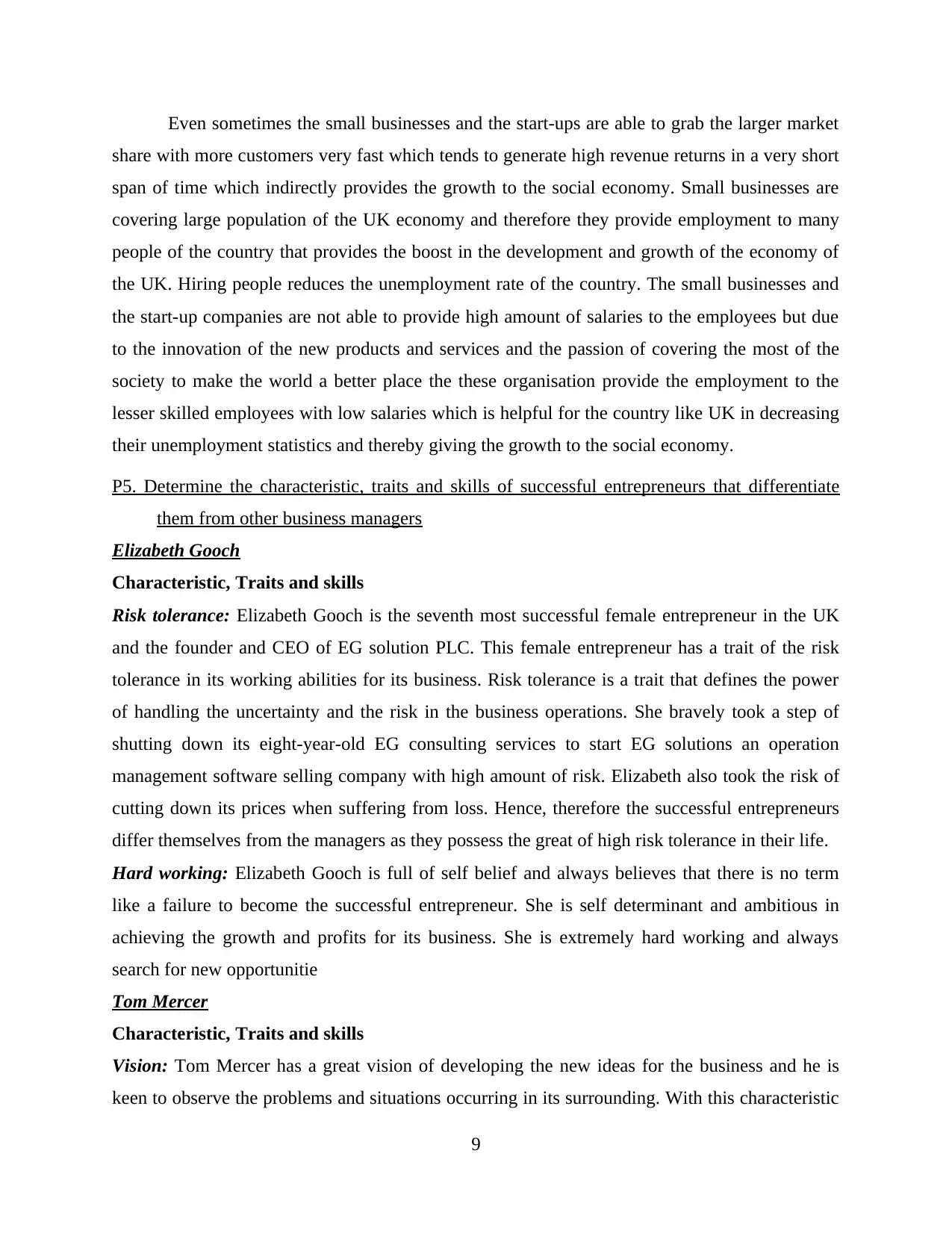
Even sometimes the small businesses and the start-ups are able to grab the larger market
share with more customers very fast which tends to generate high revenue returns in a very short
span of time which indirectly provides the growth to the social economy. Small businesses are
covering large population of the UK economy and therefore they provide employment to many
people of the country that provides the boost in the development and growth of the economy of
the UK. Hiring people reduces the unemployment rate of the country. The small businesses and
the start-up companies are not able to provide high amount of salaries to the employees but due
to the innovation of the new products and services and the passion of covering the most of the
society to make the world a better place the these organisation provide the employment to the
lesser skilled employees with low salaries which is helpful for the country like UK in decreasing
their unemployment statistics and thereby giving the growth to the social economy.
P5. Determine the characteristic, traits and skills of successful entrepreneurs that differentiate
them from other business managers
Elizabeth Gooch
Characteristic, Traits and skills
Risk tolerance: Elizabeth Gooch is the seventh most successful female entrepreneur in the UK
and the founder and CEO of EG solution PLC. This female entrepreneur has a trait of the risk
tolerance in its working abilities for its business. Risk tolerance is a trait that defines the power
of handling the uncertainty and the risk in the business operations. She bravely took a step of
shutting down its eight-year-old EG consulting services to start EG solutions an operation
management software selling company with high amount of risk. Elizabeth also took the risk of
cutting down its prices when suffering from loss. Hence, therefore the successful entrepreneurs
differ themselves from the managers as they possess the great of high risk tolerance in their life.
Hard working: Elizabeth Gooch is full of self belief and always believes that there is no term
like a failure to become the successful entrepreneur. She is self determinant and ambitious in
achieving the growth and profits for its business. She is extremely hard working and always
search for new opportunitie
Tom Mercer
Characteristic, Traits and skills
Vision: Tom Mercer has a great vision of developing the new ideas for the business and he is
keen to observe the problems and situations occurring in its surrounding. With this characteristic
9
share with more customers very fast which tends to generate high revenue returns in a very short
span of time which indirectly provides the growth to the social economy. Small businesses are
covering large population of the UK economy and therefore they provide employment to many
people of the country that provides the boost in the development and growth of the economy of
the UK. Hiring people reduces the unemployment rate of the country. The small businesses and
the start-up companies are not able to provide high amount of salaries to the employees but due
to the innovation of the new products and services and the passion of covering the most of the
society to make the world a better place the these organisation provide the employment to the
lesser skilled employees with low salaries which is helpful for the country like UK in decreasing
their unemployment statistics and thereby giving the growth to the social economy.
P5. Determine the characteristic, traits and skills of successful entrepreneurs that differentiate
them from other business managers
Elizabeth Gooch
Characteristic, Traits and skills
Risk tolerance: Elizabeth Gooch is the seventh most successful female entrepreneur in the UK
and the founder and CEO of EG solution PLC. This female entrepreneur has a trait of the risk
tolerance in its working abilities for its business. Risk tolerance is a trait that defines the power
of handling the uncertainty and the risk in the business operations. She bravely took a step of
shutting down its eight-year-old EG consulting services to start EG solutions an operation
management software selling company with high amount of risk. Elizabeth also took the risk of
cutting down its prices when suffering from loss. Hence, therefore the successful entrepreneurs
differ themselves from the managers as they possess the great of high risk tolerance in their life.
Hard working: Elizabeth Gooch is full of self belief and always believes that there is no term
like a failure to become the successful entrepreneur. She is self determinant and ambitious in
achieving the growth and profits for its business. She is extremely hard working and always
search for new opportunitie
Tom Mercer
Characteristic, Traits and skills
Vision: Tom Mercer has a great vision of developing the new ideas for the business and he is
keen to observe the problems and situations occurring in its surrounding. With this characteristic
9
Paraphrase This Document
Need a fresh take? Get an instant paraphrase of this document with our AI Paraphraser
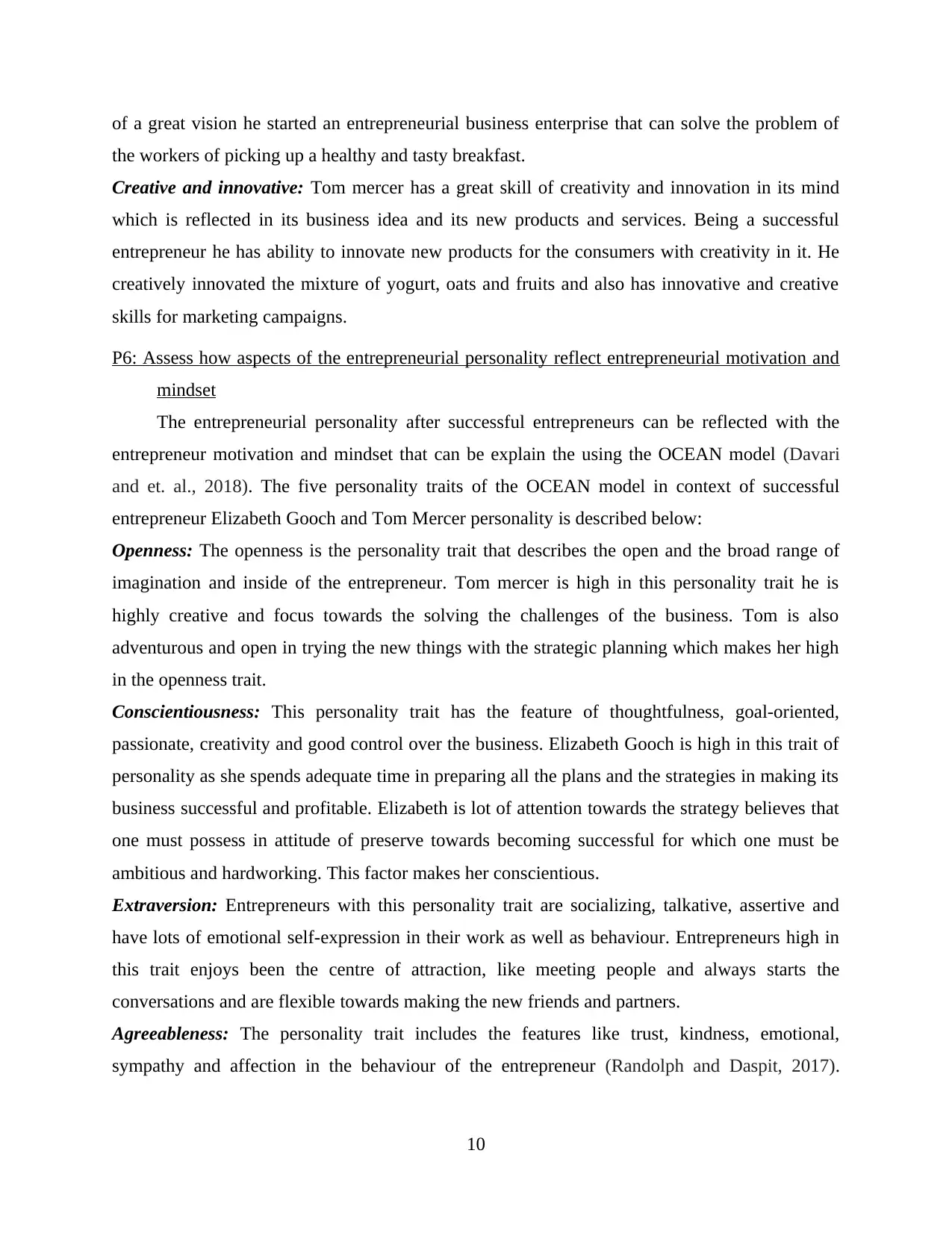
of a great vision he started an entrepreneurial business enterprise that can solve the problem of
the workers of picking up a healthy and tasty breakfast.
Creative and innovative: Tom mercer has a great skill of creativity and innovation in its mind
which is reflected in its business idea and its new products and services. Being a successful
entrepreneur he has ability to innovate new products for the consumers with creativity in it. He
creatively innovated the mixture of yogurt, oats and fruits and also has innovative and creative
skills for marketing campaigns.
P6: Assess how aspects of the entrepreneurial personality reflect entrepreneurial motivation and
mindset
The entrepreneurial personality after successful entrepreneurs can be reflected with the
entrepreneur motivation and mindset that can be explain the using the OCEAN model (Davari
and et. al., 2018). The five personality traits of the OCEAN model in context of successful
entrepreneur Elizabeth Gooch and Tom Mercer personality is described below:
Openness: The openness is the personality trait that describes the open and the broad range of
imagination and inside of the entrepreneur. Tom mercer is high in this personality trait he is
highly creative and focus towards the solving the challenges of the business. Tom is also
adventurous and open in trying the new things with the strategic planning which makes her high
in the openness trait.
Conscientiousness: This personality trait has the feature of thoughtfulness, goal-oriented,
passionate, creativity and good control over the business. Elizabeth Gooch is high in this trait of
personality as she spends adequate time in preparing all the plans and the strategies in making its
business successful and profitable. Elizabeth is lot of attention towards the strategy believes that
one must possess in attitude of preserve towards becoming successful for which one must be
ambitious and hardworking. This factor makes her conscientious.
Extraversion: Entrepreneurs with this personality trait are socializing, talkative, assertive and
have lots of emotional self-expression in their work as well as behaviour. Entrepreneurs high in
this trait enjoys been the centre of attraction, like meeting people and always starts the
conversations and are flexible towards making the new friends and partners.
Agreeableness: The personality trait includes the features like trust, kindness, emotional,
sympathy and affection in the behaviour of the entrepreneur (Randolph and Daspit, 2017).
10
the workers of picking up a healthy and tasty breakfast.
Creative and innovative: Tom mercer has a great skill of creativity and innovation in its mind
which is reflected in its business idea and its new products and services. Being a successful
entrepreneur he has ability to innovate new products for the consumers with creativity in it. He
creatively innovated the mixture of yogurt, oats and fruits and also has innovative and creative
skills for marketing campaigns.
P6: Assess how aspects of the entrepreneurial personality reflect entrepreneurial motivation and
mindset
The entrepreneurial personality after successful entrepreneurs can be reflected with the
entrepreneur motivation and mindset that can be explain the using the OCEAN model (Davari
and et. al., 2018). The five personality traits of the OCEAN model in context of successful
entrepreneur Elizabeth Gooch and Tom Mercer personality is described below:
Openness: The openness is the personality trait that describes the open and the broad range of
imagination and inside of the entrepreneur. Tom mercer is high in this personality trait he is
highly creative and focus towards the solving the challenges of the business. Tom is also
adventurous and open in trying the new things with the strategic planning which makes her high
in the openness trait.
Conscientiousness: This personality trait has the feature of thoughtfulness, goal-oriented,
passionate, creativity and good control over the business. Elizabeth Gooch is high in this trait of
personality as she spends adequate time in preparing all the plans and the strategies in making its
business successful and profitable. Elizabeth is lot of attention towards the strategy believes that
one must possess in attitude of preserve towards becoming successful for which one must be
ambitious and hardworking. This factor makes her conscientious.
Extraversion: Entrepreneurs with this personality trait are socializing, talkative, assertive and
have lots of emotional self-expression in their work as well as behaviour. Entrepreneurs high in
this trait enjoys been the centre of attraction, like meeting people and always starts the
conversations and are flexible towards making the new friends and partners.
Agreeableness: The personality trait includes the features like trust, kindness, emotional,
sympathy and affection in the behaviour of the entrepreneur (Randolph and Daspit, 2017).
10
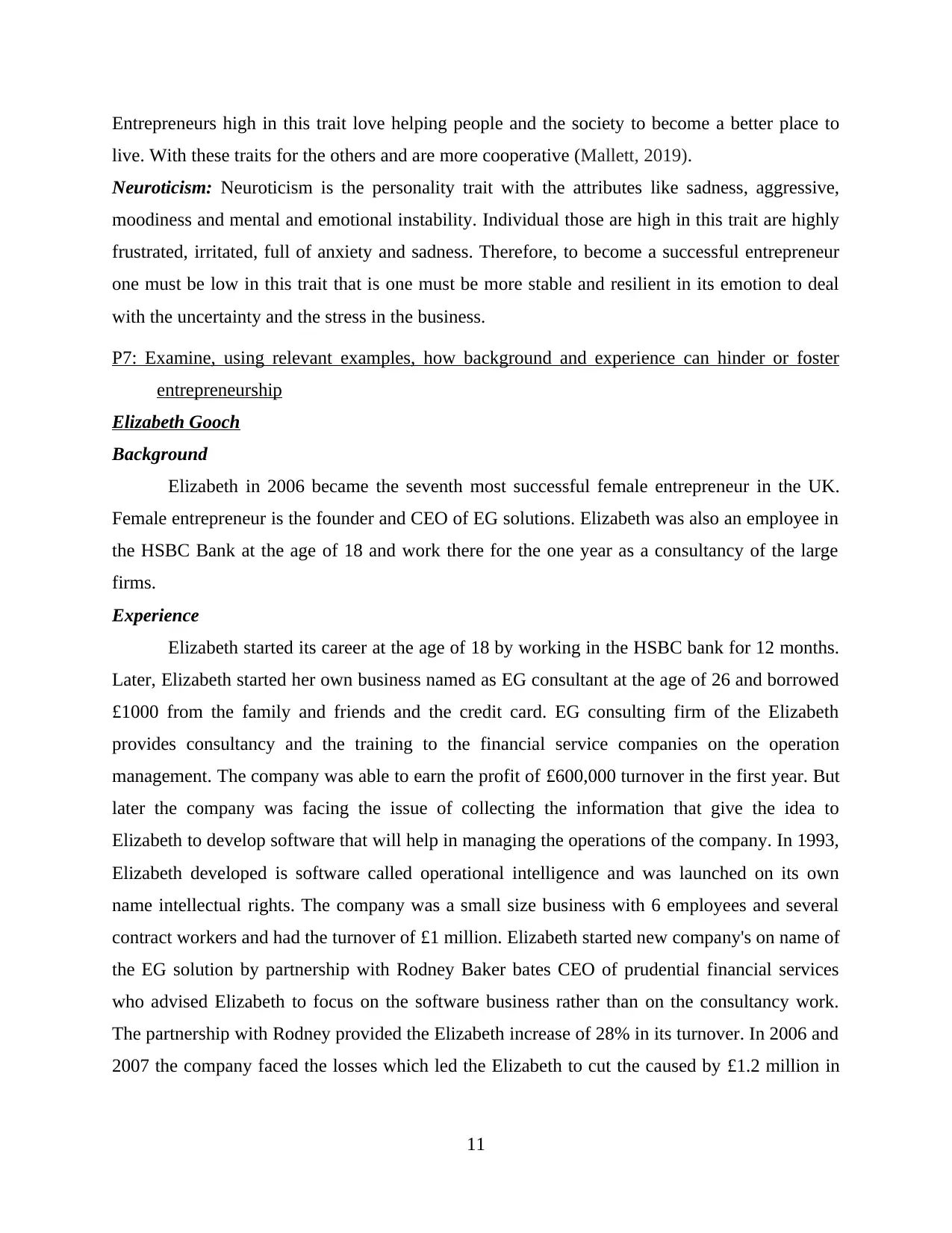
Entrepreneurs high in this trait love helping people and the society to become a better place to
live. With these traits for the others and are more cooperative (Mallett, 2019).
Neuroticism: Neuroticism is the personality trait with the attributes like sadness, aggressive,
moodiness and mental and emotional instability. Individual those are high in this trait are highly
frustrated, irritated, full of anxiety and sadness. Therefore, to become a successful entrepreneur
one must be low in this trait that is one must be more stable and resilient in its emotion to deal
with the uncertainty and the stress in the business.
P7: Examine, using relevant examples, how background and experience can hinder or foster
entrepreneurship
Elizabeth Gooch
Background
Elizabeth in 2006 became the seventh most successful female entrepreneur in the UK.
Female entrepreneur is the founder and CEO of EG solutions. Elizabeth was also an employee in
the HSBC Bank at the age of 18 and work there for the one year as a consultancy of the large
firms.
Experience
Elizabeth started its career at the age of 18 by working in the HSBC bank for 12 months.
Later, Elizabeth started her own business named as EG consultant at the age of 26 and borrowed
£1000 from the family and friends and the credit card. EG consulting firm of the Elizabeth
provides consultancy and the training to the financial service companies on the operation
management. The company was able to earn the profit of £600,000 turnover in the first year. But
later the company was facing the issue of collecting the information that give the idea to
Elizabeth to develop software that will help in managing the operations of the company. In 1993,
Elizabeth developed is software called operational intelligence and was launched on its own
name intellectual rights. The company was a small size business with 6 employees and several
contract workers and had the turnover of £1 million. Elizabeth started new company's on name of
the EG solution by partnership with Rodney Baker bates CEO of prudential financial services
who advised Elizabeth to focus on the software business rather than on the consultancy work.
The partnership with Rodney provided the Elizabeth increase of 28% in its turnover. In 2006 and
2007 the company faced the losses which led the Elizabeth to cut the caused by £1.2 million in
11
live. With these traits for the others and are more cooperative (Mallett, 2019).
Neuroticism: Neuroticism is the personality trait with the attributes like sadness, aggressive,
moodiness and mental and emotional instability. Individual those are high in this trait are highly
frustrated, irritated, full of anxiety and sadness. Therefore, to become a successful entrepreneur
one must be low in this trait that is one must be more stable and resilient in its emotion to deal
with the uncertainty and the stress in the business.
P7: Examine, using relevant examples, how background and experience can hinder or foster
entrepreneurship
Elizabeth Gooch
Background
Elizabeth in 2006 became the seventh most successful female entrepreneur in the UK.
Female entrepreneur is the founder and CEO of EG solutions. Elizabeth was also an employee in
the HSBC Bank at the age of 18 and work there for the one year as a consultancy of the large
firms.
Experience
Elizabeth started its career at the age of 18 by working in the HSBC bank for 12 months.
Later, Elizabeth started her own business named as EG consultant at the age of 26 and borrowed
£1000 from the family and friends and the credit card. EG consulting firm of the Elizabeth
provides consultancy and the training to the financial service companies on the operation
management. The company was able to earn the profit of £600,000 turnover in the first year. But
later the company was facing the issue of collecting the information that give the idea to
Elizabeth to develop software that will help in managing the operations of the company. In 1993,
Elizabeth developed is software called operational intelligence and was launched on its own
name intellectual rights. The company was a small size business with 6 employees and several
contract workers and had the turnover of £1 million. Elizabeth started new company's on name of
the EG solution by partnership with Rodney Baker bates CEO of prudential financial services
who advised Elizabeth to focus on the software business rather than on the consultancy work.
The partnership with Rodney provided the Elizabeth increase of 28% in its turnover. In 2006 and
2007 the company faced the losses which led the Elizabeth to cut the caused by £1.2 million in
11
⊘ This is a preview!⊘
Do you want full access?
Subscribe today to unlock all pages.

Trusted by 1+ million students worldwide
1 out of 15
Related Documents
Your All-in-One AI-Powered Toolkit for Academic Success.
+13062052269
info@desklib.com
Available 24*7 on WhatsApp / Email
![[object Object]](/_next/static/media/star-bottom.7253800d.svg)
Unlock your academic potential
Copyright © 2020–2025 A2Z Services. All Rights Reserved. Developed and managed by ZUCOL.




